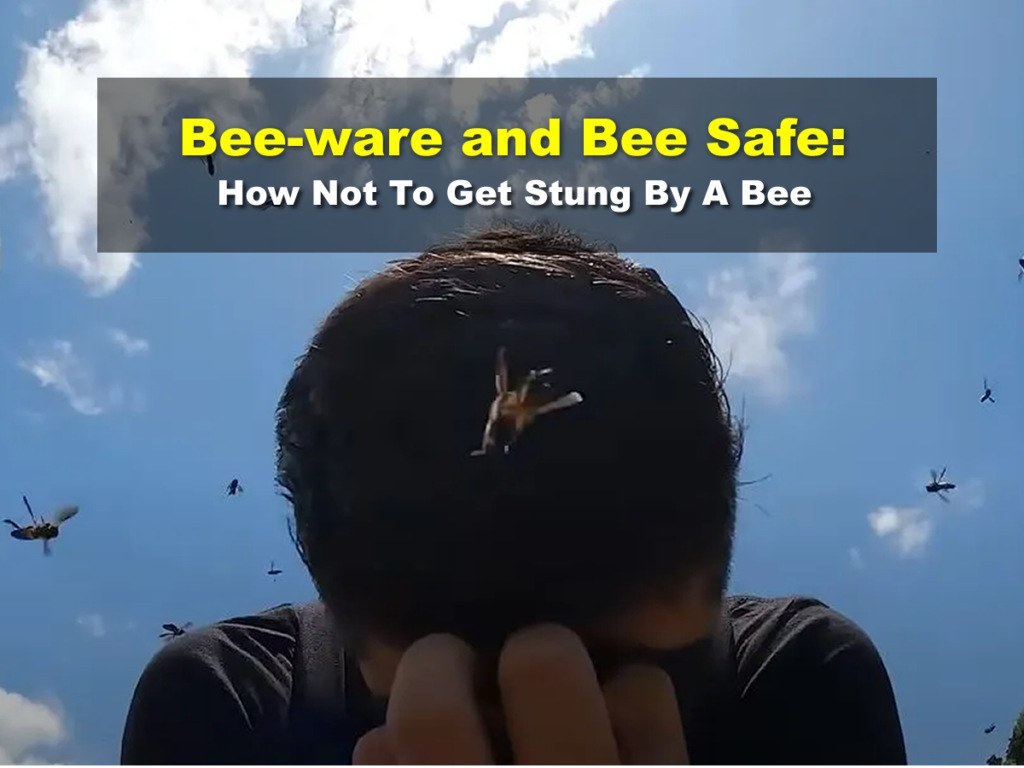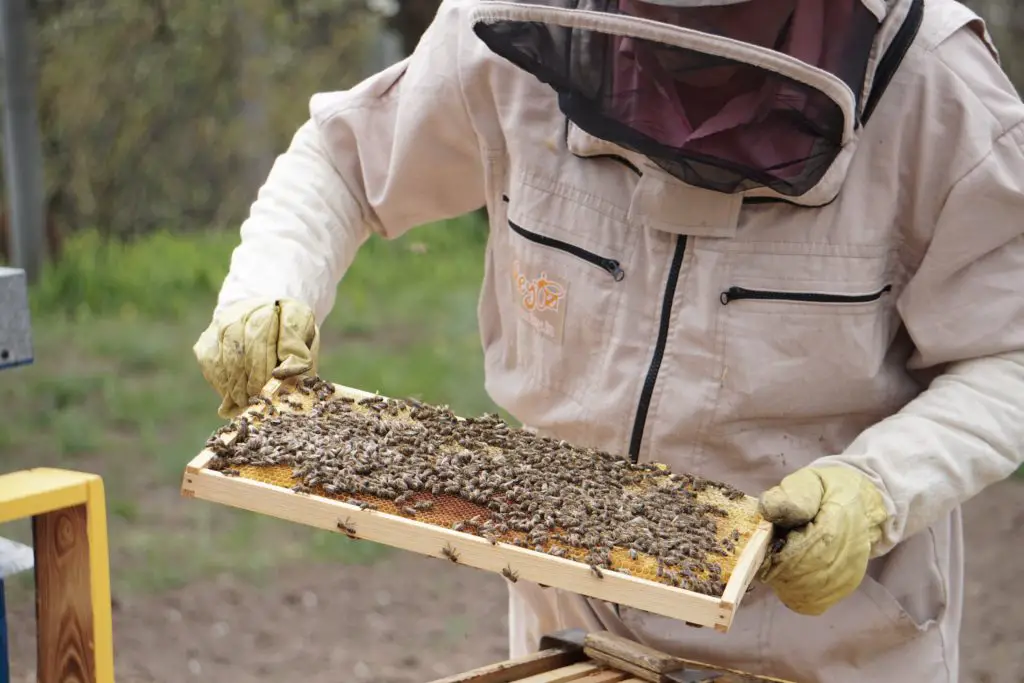Affiliate Disclaimer - As an Amazon Associate I earn from qualifying purchases.
It supports the website. So, Thank you
You’re either one of two types of people; someone who remains perfectly still around bees or someone that runs away, flailing their arms. Whatever your reaction, your main motive is to avoid being stung but what’s the truth about how not to get stung by a bee?
Avoiding areas where there are bees’ nests is one way to prevent being stung. However, if you find yourself in the presence of bees, it’s important not to frighten them. Most species only sting when they feel threatened so approaching the hive, swatting them, or making sudden movements could all see you getting a nasty sting.
There are plenty of things you can do to exist happily alongside nature. In this post, I’ll be looking in more detail at some of the most effective ways to avoid being stung by a bee.
Table of Contents
Do All Bees Sting?
If there’s anything that bees are famous for, aside from making honey, it’s their ability to sting. However, not many people know that not all bees are capable of stinging.
In some species, it’s only the females that are able to sting. For example, the male carpenter bee doesn’t have a stinger and will simply fly at you as a warning to keep away from the nest.
Common bees in North America, such as the honey bee and the bumble bee are able to sting. But they don’t do this for fun. In fact, honey bees will die once they sting you as their barbed stinger gets lodged in the skin and, as they pull away, this is torn from their bodies. They’re left with a fatal wound and no hope of survival. While it’s not thought that honey bees know their fate, there must be some kind of ingrained sense because this very docile species will only sting if absolutely necessary.
In North America, there are several bee species that cannot sting at all. One example is the Sugarbag bee which is slightly smaller than the European honey bee. If you’re afraid of being stung then it might be worth getting clued up on how to identify different bee species so you know whether there’s a chance of being stung or not.
Are Bee Stings Harmful?
Bees do have venom glands but these do not produce any toxins that are potent enough to cause serious harm to humans.
That said, there are some people that are allergic to bee stings, in which case, the effects could be extremely serious, even life-threatening.
While it is possible to have a blood test to measure your immunity to allergens within bee venom, most people typically discover that they have an allergy after a sting. In the event that you’re stung and notice any unusual symptoms such as excessive swelling, shortness of breath, nausea or vomiting, rapid pulse, or dizziness then you should seek urgent medical attention.

How Can I Avoid Being Stung By A Bee?
Bee stings might be harmless, if not painful and irritating, to most people but I don’t know anyone that actively goes out looking to get stung. Keep in mind that pretty much all bee species only sting when they feel threatened so it’s no fun for them either.
But if you’re planning to spend any time outdoors this spring and summer then you’re going to have to face the fact that you’ll be sharing nature with bees. Bees just want to go about their business without interacting with humans. But our paths will often cross so here are my top tips on a stingless interaction.
Stay Still And Don’t Make Sudden Movements
If you watch a beekeeper, you’ll notice that he or she makes very slow and controlled movements around the bees. They’ll also wear a bee suit but that’s not something I’m going to suggest you do at your next picnic or garden party.
The point of making slow movements is to avoid scaring the bees. When they are exposed to sudden movements, this is seen as a threat and they’ll become aggressive.
A lot of the time, the bee will simply want to take a look around before flying off and leaving you to get on with your day. They’re not naturally angry insects and won’t just attack for the sake of it. As long as you keep still and show no sign of being threatening, the bee will soon leave.
Don’t Keep Food Outdoors
If you’re looking to keep bees at bay then one of the worst things you can do is leave food and drinks outdoors. Now, let’s face it, if you’re having a BBQ or a picnic, the food needs to be outside. However, that doesn’t mean that it can’t be covered up.
Bees are always foraging but they can’t tell the difference between a tasty can of soda and the nectar from a flower. To them, they’re both sugary treats and they’ll quite happily hang around if there’s a source of food. They may even signal to other bees who’ll also come to take a look.
The solution is simple; cover your food when you’re not eating and, where possible, put it back inside the house.
Don’t Aggravate The Bees
I’ve talked about staying still and not making sudden movements but that’s not the only way you can annoy a bee. Many people will swat the bee or throw something at it but this is going to do you no favors.
I understand that it’s almost like a reflex to lash out and swat a bee if it unexpectedly flies at you but you’re only going to wind it up. Try to show restraint and avoid swatting the bee because it’ll only see you as a threat, and who could blame it? Imagine being hit by a giant hand and tell me that you wouldn’t go into defensive mode!
You also have to keep in mind that when bees are aggravated, they send out a pheromone signal to other members of their colony. This is called the alarm pheromone and it tells all the other bees to come and fight. The last thing you want is to have to deal with several bees as opposed to just one.
Think About Your Clothes And Fragrance
We all know that bees are attracted to flowers so if you spray yourself in a floral perfume, this is going to attract bees. Even heavily scented shampoos, hairsprays, body lotions, and other cosmetics can cause the bees to come and investigate. Therefore, I would recommend using non-scented or very lightly scented products if you know you’re going to be out in nature.
What’s more, you need to think about your outfit choices and I’m not just talking for fashion’s sake. Bees are attracted to certain colors, especially on the blue, green, and violet spectrums. They can’t see red so, while it is bright, it’s a safe bet.
You also need to think about the length of your sleeves and pants. Wearing clothing that covers up as much skin as possible will mean less chance of being stung. Of course, if the weather is warm, you don’t want to cover up completely and feel hot. Wearing lightweight and breathable fabrics will keep you cool and protected; it’s a win-win!
Wear Shoes Outdoors
I know that running through the grass barefoot is one of the most invigorating feelings in the world. But it comes with its risks and one of those risks is being stung by a bee.
When most people think of bees, they imagine the nest being higher up. But many species are ground nesters so they’ll often be found wandering among the blades of grass. What’s more, where there are pollen-producing flowers, there are bees and your lawn might be full of them.
For this reason, it is vital to always wear suitable footwear, especially when you’re walking in long grass with decreased visibility. If you have children, this is very important to keep in mind.
Leave Bee Nests Alone
I have a friend who thought it would be funny, as a kid, to poke at a bee’s nest. Let me tell you that he didn’t think it was so funny when the colony went into defensive mode and stung him repeatedly.
While humans may be fascinated with nature, that doesn’t mean that we should go messing around with it. Bee nests and hives are incredible structures with a bee hierarchy and lots of important work going on inside. Why do we need to interfere?
What’s more, you have to consider that interfering with a bee hive in any way is only going to rile the bees up. You’d feel the same if someone came poking around your home. So, leave them to their own business and, if you’re keen to observe them, do it from afar.
Look At The Cues
Sometimes, you can do everything in your power to avoid being stung by a bee but the insect may get worked up anyway. If you’re around bees, it’s a really good idea to monitor their behavior as this will tell you a lot about their next move.
A bee that is not a threat will be happily buzzing around and will likely leave the scene after a minute or two once it realizes that there’s nothing there for it.
However, an aggressive bee tends to fly more erratically and, if there are several, they may even cluster around your head. If you’re dealing with a swarm or large cluster of bees then you’ll find that their buzzing gets louder.
When you notice any of these things, it is best to slowly take yourself out of the situation and leave the bees alone.
Do Insect Repellents Work Against Bees?
A lot of people like the idea of using an insect repellent to deter bees but it has been proven that there are no topical repellents that are effective against stinging insects like bees and wasps.
However, this is something that I’m quite pleased about since some of these repellents may contain ingredients that are harmful to bees. While I want to avoid being stung, I also want to avoid hurting the bees in any way as they’re important pollinators.
The good news is that there are lots of natural products that you can use as bee repellent. These include things like citronella oil, eucalyptus oil, rosemary oil, clove oil, and peppermint oil. By applying these with carrier oil to the skin, you’ll successfully keep bees away.
What To Do If You Get Stung
Getting stung by a bee is never fun. It can cause localized swelling, redness, pain, itching, and irritation. But for most people, it’s a minor injury that will largely get better on its own.
There are some things you can do to lessen the pain and irritation such as using a cold compress or taking over-the-counter pain medication.
But before you do any of that, you will need to remove the stinger. Contrary to popular belief, you should NOT use tweezers to pull the stinger out as this can release more venom. Instead, take a straight-edged object or simply your fingernail and run this over the site to painlessly remove the sting.
Once the stinger is out, you’ll need to wash the area with warm water and soap. If you aren’t sure whether you are allergic to bee stings then it’s a good idea to monitor yourself for unusual symptoms such as those that I discussed earlier in this guide. If you notice anything then contact your doctor or emergency room as soon as possible.
For those that are already aware of a bee sting allergy, it is vital that you seek medical attention or use any prescribed drugs as soon as possible after the event.
Final Thoughts
Nobody wants to get stung by a bee. But it’s, unfortunately, one of those things that happen to most of us at some point or another. If you’re looking for ideas on how not to get stung by a bee then you should make sure that you stay still, don’t be a threat to the bee, and avoid wearing floral-scented perfumes.
Of course, there will be times that, no matter what you do, a sting is inevitable. In these cases, be sure to treat the wound properly and seek medical advice if you think you are having an allergic reaction.




